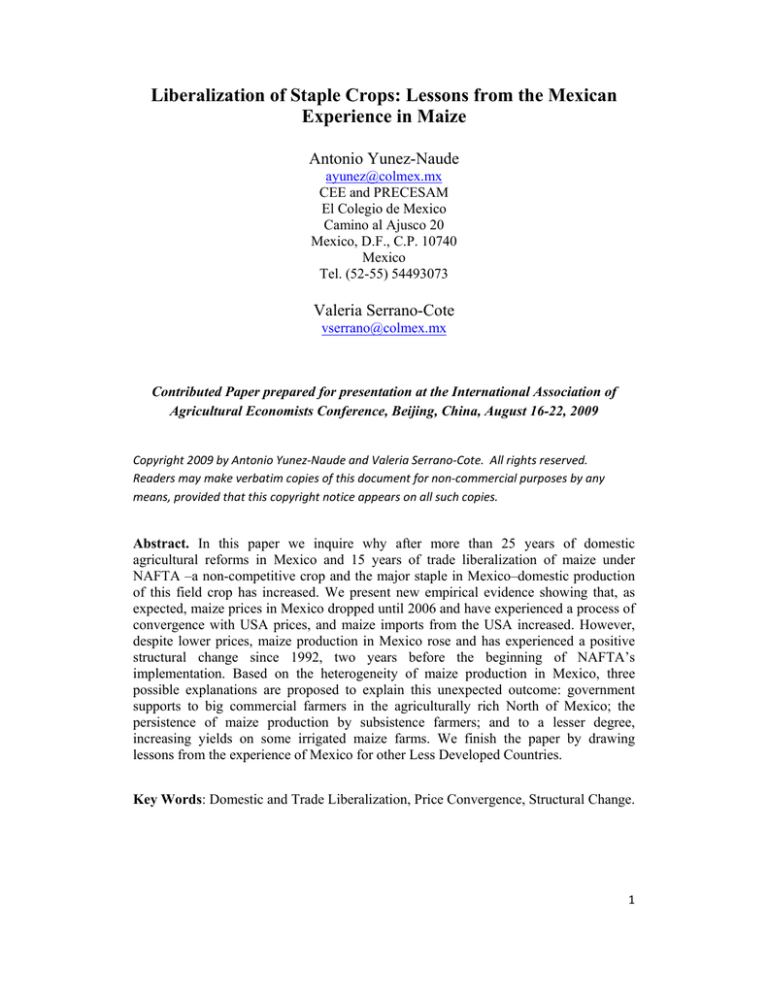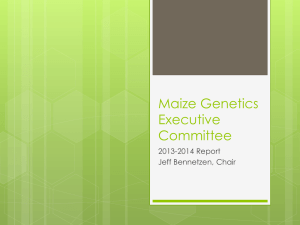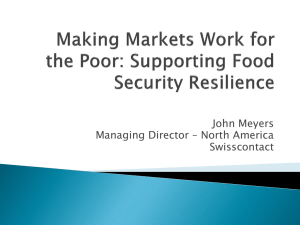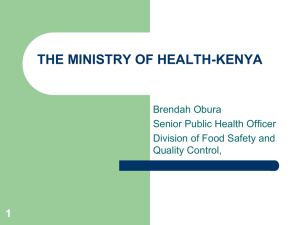
Liberalization of Staple Crops: Lessons from the Mexican
Experience in Maize
Antonio Yunez-Naude
ayunez@colmex.mx
CEE and PRECESAM
El Colegio de Mexico
Camino al Ajusco 20
Mexico, D.F., C.P. 10740
Mexico
Tel. (52-55) 54493073
Valeria Serrano-Cote
vserrano@colmex.mx
Contributed Paper prepared for presentation at the International Association of
Agricultural Economists Conference, Beijing, China, August 16-22, 2009
Copyright 2009 by Antonio Yunez‐Naude and Valeria Serrano‐Cote. All rights reserved. Readers may make verbatim copies of this document for non‐commercial purposes by any means, provided that this copyright notice appears on all such copies. Abstract. In this paper we inquire why after more than 25 years of domestic
agricultural reforms in Mexico and 15 years of trade liberalization of maize under
NAFTA –a non-competitive crop and the major staple in Mexico–domestic production
of this field crop has increased. We present new empirical evidence showing that, as
expected, maize prices in Mexico dropped until 2006 and have experienced a process of
convergence with USA prices, and maize imports from the USA increased. However,
despite lower prices, maize production in Mexico rose and has experienced a positive
structural change since 1992, two years before the beginning of NAFTA’s
implementation. Based on the heterogeneity of maize production in Mexico, three
possible explanations are proposed to explain this unexpected outcome: government
supports to big commercial farmers in the agriculturally rich North of Mexico; the
persistence of maize production by subsistence farmers; and to a lesser degree,
increasing yields on some irrigated maize farms. We finish the paper by drawing
lessons from the experience of Mexico for other Less Developed Countries.
Key Words: Domestic and Trade Liberalization, Price Convergence, Structural Change.
1 Liberalization of Staple Crops: Lessons from the Mexican Experience in Maize
1. Introduction
Mexico is an extraordinary laboratory in which to study agricultural development
policies and trends under trade liberalization. In the 1980s, the Mexican state began a
process of deep economic reform. It culminated in January 2008, with the end of the
transitional period and “full” implementation of agricultural trade liberalization with
Canada and the United States of America (USA) under the North American Free Trade
Agreement or NAFTA. (This agreement was the first one signed between a less
developed country (LDC) and highly industrialized economies.) NAFTA critics in
Mexico expected that the agreement would sharply reduce the country’s production of
non-competitive staple crops. The greatest concern was maize, the main crop consumed
by Mexicans (see for example Randall, 1996). After more than 15 years of NAFTA’s
implementation, and notwithstanding the decline of maize prices up to 2006 and a
continuous growth of imports, production of maize in Mexico has increased. As well as
contrasting with NAFTA critics´ expectations, this trend differs from the predictions of
applied general equilibrium models for the Mexican economy built in the early 1990s to
estimate the effects of NAFTA on Mexico´s agricultural sector (Levy S. y S. Van
Wijnbergen 1994 y Robinson, et al, 1993).
An analysis of the characteristics of Mexican maize prices, production and imports
during the last 27 years is relevant not only for Mexico but also for other LDCs that
have liberalized their staple sectors through bilateral free trade agreements. Examples
include Central America and the Dominican Republic under the Central American Free
Trade Agreement with the USA (CAFTA), as well as new agreements between the USA
2 and Peru and, in the near future, probably Colombia. Furthermore, Mexican maize
supply is an important case to consider in the Doha Round discussions on agricultural
trade liberalization under the World Trade Organization.
In Part 2 we summarize domestic reforms in Mexico and agricultural trade liberalization
under NAFTA, with reference to maize. After revising the tendencies in maize prices,
production and imports, in Part 3 we present our main econometric results on price
convergence and on structural change in maize imports, production and yields. Part 4
advances hypotheses intended to explain why maize production in Mexico has not
declined. We end in Part 5 with a reflection about lessons provided by the Mexican
experience.
2. Reforms and NAFTA
In order to modernize and promote efficiency in agriculture, the Mexican government
began in the mid-1980s to dismantle state enterprises involved in the food chain and to
eliminate agricultural production and consumption subsidies. This process was
deepened at the beginning of the 1990s and culminated with NAFTA’s implementation
from 1994 to 2008.
One major player of government intervention in agriculture prior to reforms and
NAFTA had been the National Company of Popular Subsistence (with the Spanish
acronym of CONASUPO). By supporting prices for the producers of “basic crops”
(maize, among other ten field crops), storing, and distributing these crops at subsidized
prices and by regulating their trade through direct imports, CONASUPO exerted control
over an important component of Mexico’s food chain.
3 Beginning in 1991, a major reform in Mexican state intervention in staple production
consisted of the elimination of guaranteed prices that CONASUPO had traditionally
awarded to the producers of basic crops all over the country. By 1999, all of these price
supports were eliminated, and CONASUPO was abolished. (Subsidies for tortillas (flat
maize bread) ended in 2001.)
During the process to reform the agriculture of Mexico, agencies and programs were
created to support the farmers of basic crops in order to ease their transition to a
liberalized agricultural sector.
In 1991, an agricultural marketing agency, Support Services for Agricultural Marketing
(ASERCA is its acronym in Spanish), was created. ASERCA is independent of
CONASUPO but, like CONASUPO, is part of the Agricultural Ministry. ASERCA was
a key element in the process of eliminating CONASUPO interventions in the markets
for the crops that had been under CONASUPO control, including maize. Similar to the
deficiency payment program in the USA, the main functions of ASERCA have been
directed towards marketing supports for commercial producers of cereals and oilseeds
for designated surplus regions. ASERCA also assists beneficiary farmers in negotiating
contracts with purchasers, and it supports contracts to cover the risk of price changes.
ASERCA is also in charge of a program of direct income transfers to farmers. This
program, called PROCAMPO (Program for Direct Supports to the Countryside), was
created in the Autumn/Winter agricultural season of 1993, some months before the
beginning of NAFTA’s implementation. In contrast with ASERCA´s marketing
supports, PROCAMPO is decoupled from production, since the transfer is based on
farmers’ areas cultivated in basic crops prior to the program, its amount is independent
of yields, and farmers who receive PROCAMPO are free to change their land use. In
4 2003 pesos, using a conversion rate of 10 pesos per USD, the transfers have been
around 100 USD per hectare (Ha.) PROCAMPO was programmed to last until 2008,
when full liberalization under NAFTA would be reached. However, the present
Administration (2007-2012) has decided to continue it, with some modifications.
PROCAMPO covers almost all landowners who used their land to grow basic crops a
couple of years before NAFTA’s initiation, around 3 million beneficiaries in all).1
3. Effects of the reforms and NAFTA on Mexico´s maize sector
Prior to the reforms, Mexico’s guarantee price (precio de garantía) had supported the
maize price. As expected, from the beginning of the reforms and especially during
NAFTA’s implementation, the price of maize received by Mexican producers decreased
(up until 2006) and imports—most from the USA, Mexico´s major trade partner—
increased. However, domestic production of maize experienced high growth rates (see
Table 1).2
Maize from the USA entered practically tariff-free during the NAFTA transitional
period (1994 to 2007).3 Declining maize prices both in Mexico and in the USA and
worldwide suggests that there was a process of convergence between Mexico and USA
1
A third major program created by the Mexican State during this period was the
Alliance for the Countryside (Alianza para el Campo). Alliance has a rural coverage
that is not directly related to maize production. 2
With the exception of prices, the figures in this Table come from the data used in the
econometric estimations presented below. 3
During the NAFTA transition period, the agreed Tariff Rate Quotas between Mexico
and the USA were not applied when maize imports exceeded the quota. Based on
empirical evidence, we consider here that imported yellow maize is a substitute for
domestically produced white corm in production and consumption. 5 maize prices. We test the convergence hypothesis below. We also inquire empirically
whether structural change in Mexico´s maize production and in imports occurred during
the agricultural reform and NAFTA phase-in period. Finally, we test for structural
change in maize yields, inasmuch as their observed rise—together with rising domestic
demand for maize—may explain why domestic production increased in the face of
lower prices and higher imports.
Table 1. Evolution of the maize sector: 1980-2006
(annual averages)
Period
1980-86
19871993
19942006
Prices
(pesos/mt.
Ton.) *
Imports
(mt. tons)
Production
(mt. tons)
Yields
(mt.
Tons/Ha.)
8,738
2,549,897
12,638,873
1.83
7,083
2,543,807
13,870,518
1.98
3,814
5,134,009
19,156,933
2.55
* Producer prices in 2002 pesos (consumer price index, Bank of Mexico)
Sources: Prices, production and yields, 1980-2005, Sistema de Información
Agroalimentaria de Consulta, SIACON; 2006, Servicio de Agroalimentaria
y Pesquera, SIAP (http://www.siap.gob.mx). Imports: FAO, http://faostat.fao.org
Price Convergence
What is the short and long run relationship between maize prices in Mexico and the
USA? Do maize prices in Mexico have a tendency to converge with USA prices? We
consider USA prices because almost all of Mexico´s imports come from this country
and because the USA is a global price leader in this crop.
We used monthly price data from January 1981 to April 2008. The data for Mexico is
based on the price index received by maize producers valued at the nominal peso/USD
exchange rate. For the USA, two price time series were considered separately: farm
6 gate prices and FOB shipping-point prices. (Both are available on the website of the US
Department of Agriculture, National Agricultural Statistics Service).
The price convergence analysis was based on the theory of Purchasing Power Parity,
following the econometric error correction model of Engle and Granger (see for
example, Maddala, G.S. and Kim, I., 1998, and Enders W., 2004).
The model used for the estimation is:
Δpt = α1 + α2Δft + α3[pt-1 - β1 ft-1] + εt
Where pt is the price of maize in Mexico; coefficient α2 indicates price transmission
during the first period to the Mexican price pt coming from a change in the USA price,
adjusted by the exchange rate ft (short run effect); and coefficient α3 is the rate of
adjustment of the Mexican price in consecutive periods (long term effect).
Our findings are summarized in Table 2. They show that the error correction coefficient,
α3, is statistically different from 0 when using either USA maize farm gate prices or
FOB prices. These results show evidence of the existence of convergence between
Mexico and USA maize prices, and so, they indicate the following: 1) If the price in
Mexico is 1% higher than the USA farm gate price, the former will drop by 0.07% in
the following month (0.03% if the Mexican price is 1% higher than the USA FOB
price); 2) After 5 months the adjustment of the price in Mexico would reach 31% of the
change in the US farmgate price (15% for the FOB price); and 3) it takes 41 months for
the price in Mexico to reach a 95% adjustment to the US farm gate price (92 months
using the FOB US price).
7 Table 2. Results, Cointegration between Mexican and US maize prices
Maize
(farm gate)
Maize
(fob)
α1
0.021
(6.62)
.0201926
( 6.50)
α2
-0.013
(-0.29)
-.0036427
(-0.27)
α3
-0.069
(-6.56)
-.031896
(-3.43)
R^2 DW
t=5
0.117 1.778 0.311
n for k =
.95
41.419
0.041 1.726 0.153
92.303
Notes: "t" is the percentage of adjustment in period 5
"n" is the number of periods (months) for Mexican prices to reach a 95% adjustment
t statistics are in parentheses
Source: Own estimation
The results from previous studies do not contradict our findings. Using the same
methodology and price series for Mexican and USA producers for a shorter period
(January 1981 to March 2003), we found evidence indicating a 38% adjustment of the
Mexican price of maize to the USA price over five months, and a 95% adjustment in 37
months. The differences between these and our updated results is that price adjustment
takes longer when we include the more recent period. This could be explained by a
change in policy implemented in 2003 by the Mexican government. It consisted of
giving surplus commercial farmers of basic crops, rather than buyers, most of the
subsidies in ASERCA´s marketing support program. In addition, since then ASERCA´s
budget for this purpose has increased.
Our results also support those of Fiess, R. y D. Lederman (2004), who use a different
estimation methodology (one proposed by Johansen). They found evidence that the
“Law of One Price” has ruled for maize prices in Mexico and in the USA. They divide
the period under study into two, before and after NAFTA’s implementation, and present
empirical evidence that NAFTA has not affected the relationship between Mexico and
USA maize prices.
8 Structural changes in maize imports, production and yields
For the analysis of structural change we used time series data from 1970 to 2006 for
Mexico´s volume of imports and production of maize, as well as yields (Mt. Tons per
Ha.). Following Vogelsang (1999) we first tested the existence of unit root in the series
and then, using the approach of Zivot and Andrews (1992), we tested for the presence of
structural change for the stationary series. For the case of a non-stationary series we
also inquired into the presence of sudden or temporary shocks, following Vogelsang.
The estimation model is the following:
y t = u + θDU t + β t + γDTt + αy t −1 +
k
∑ c Δy
j
t− j
+εt
j =1
Where yt is the variable subject to test for structural change. DU is a dummy variable:
DUt = 1 if t> TB and 0 otherwise; DTt = t if t>TB , and 0 otherwise. The equation is
estimates sequentially for values TB = 2,...,T-1, where T is the number of observations
once the difference of the variables are applied. The period of rupture is elected when
the value of the Dick Fuller statistic t of α is maximized. The null hypothesis is that
variable y presents a unit root and the alternative hypothesis is that it is stationary with a
rupture in its tendency. (Details of the econometric procedures are available upon
request.)
The results show that time series for maize volume of imports is not stationary (Table
3). However, there is weak evidence of structural change in 1991 and evidence of the
presence of a temporary shock in 1993. A look at the data suggests the meaning of these
results: Mexico’s maize imports declined from 4.124 million metric tons in 1990 to
1.449 million in 1991, 1.343 in the following year and 0.293 in 1993. After 1994,
9 however, maize imports increased. They reached an average of 2.782 million during
1994-1995 and 5,134 million in1994-2006 (Table 1).
Results on maize production provide evidence that maize supply in Mexico experienced
a structural or “permanent” change in 1992 (Table 3). The change was positive,
contrasting with the expectation that agricultural liberalization and NAFTA would
negatively affect maize production in Mexico.
As in the case of imports, there is no evidence that the series for maize yields is not
stationary, but there is weak evidence that yields suffer a positive structural change
beginning in 1986. Table 3. Results, temporal and structural change in production and
maize imports
Imports *
Production *
Yields *
Unit Root
Not rejected
Rejected
Not rejected
Temporary
Schock
1993
None
None
Structural
Change
1991
1992
1986
Sign **
(+)
(+)
(+)
* Tests at a 5% significance level
** Signs obtained by comparing average of the data series before and after the detected
change
Sources: own estimations. Data for imports, same as Table; data for production and yields,
1970-1979, from Nacional Financiera, and 1980-2006, same as Table 1.
4. Why Has Maize Production in Mexico Not Declined?
To understand why maize domestic supply in Mexico has not declined under
liberalization measures we start with the following premise: any study of production
decisions has to consider the heterogeneity of Mexican maize famers. (This premise
also applies to agricultural production in other LDCs.) We refer to the coexistence of
commercial maize producers with family farming, that is, with rural households
10 producing maize for their own consumption while engaged in other family activities to
diversify their income sources: e.g. production of other crops, livestock, migration and
remittances, local nonfarm as well as farm wage work, etc.
Whereas commercial producers of maize respond directly to price changes, family
farmers may not; i.e. subsistence maize producers are price inelastic, either because of
the presence of high transaction costs, or because they react in apparently unexpected
ways to changes in maize output market prices. For the first hypothesis see de Janvry et.
al. 1995. With respect to the second hypothesis, using a microeconomic computable
general equilibrium model (MCGE), Dyer, Boucher and Taylor (2006) find for a
Mexican village that a maize market price shock is indirectly transmitted to subsistence
producers through interactions in factor markets. They conclude that a drop in the
market price of maize reduces local wages and land rents, stimulating maize production
by subsistence households. (They also find that the real income of subsistence
households falls.)
Based on these results and on similar findings for Mexico’s rural regions using a similar
MCGE and data provided by a representative rural household survey for 2002, we
propose that subsistence farmers reactions to the observed reduction of maize market
prices is one explanation for maize production in Mexico not declining.
With respect to commercial medium and big maize farmers, we propose the following
hypotheses: some of these farmers have reacted to price reductions by increasing
productivity/yields; others have changed their land use for other purposes; and the
remaining have been isolated from USA competition through government supports. No
time series are available to test these three hypotheses. However, existing figures do not
contradict them.
11 We have some evidence that maize yields experienced structural change in 1986.
Available data on maize yields that distinguish irrigated from rain-fed lands show that
increasing yields are concentrated on irrigated lands farmed by commercial producers.
(Maize yields in irrigated land increased from around 3 Mt. tons per hectare in the
1980s to 6 Mt. tons in the present century.) By contrast, maize yields on rain-fed lands –
where small and subsistence farm production is concentrated—have remained low
(from 1.5 Mt. tons per hectare during the 1980s to just 2 Mt. tons during the first years
of the 2000s, according to the Mexican Ministry of Agriculture’s on-line database).
With respect to government supports, income subsidies for marketing from ASERCA
(Target Income, or Ingreso Objetivo) have been channeled to commercial maize
farmers, most in the northwest state of Sinaloa and with access to irrigation. Excluding
PROCAMPO, around 70% of ASERCA’s budget is used to support the income of
surplus farmers of basic crops (between 430 and 600 million USD per year). 50% of
this subsidy goes to this type of maize producer, of which 70% is for farmers in a single
northwestern state, Sinaloa.
Sumner and Balgatas (op. cit.) provide evidence that the Target Income program has
promoted maize production by its beneficiaries. The program thus is coupled and has
isolated some maize surplus producers from foreign competition.
Regional data on maize production show that Sinaloa has displaced other states as the
major producer of this cereal: Sinaloa’s share in the volume of total domestic supply
was less than 0.7% at the beginning of the 1980s and increased to more than 10.5%
during 1991-2007. In contrast, the southeastern state of Chiapas, the major state
producing maize during the 1980s, saw its share of domestic supply fall from more than
9.6% to 6.2% during these periods (the same applies to other states of the South and
12 center of Mexico that have been traditional maize producers). Both area planted and
yields by maize producers in Sinaloa have increased, but the area planted in maize has
increased more than yields (Mexico´s Ministry of Agriculture, on-line database).
In addition to Target Income, PROCAMPO’s direct income and decoupled transfers to
maize producers may also help explain why maize production in Mexico has not
collapsed (see de Janvry et. al. op. cit).
5.
Lessons from the Mexican Experience
The increase in maize production in Mexico during the period of agricultural reforms
and trade liberalization may be taken as a success story by those who worry about food
security in LDCs. However, growth in the domestic supply of maize has been mainly
based on subsidizing big commercial farmers in the northwest of Mexico. By isolating
these producers from competition, this type of policy conflicts with the efficiency goals
of trade liberalization, and hence is inefficient and costly. At the other extreme, smallscale agricultural households have not benefited from government supports, with the
exception of PROCAMPO´s direct income transfers. The minority of small producers
whose maize production was oriented largely for sale in markets were negatively
affected by declining maize prices following the reforms. Meanwhile, production in
subsistence households increased. Both types of households suffered income drops.
Agricultural programs in contemporary Mexico are not only costly and inefficient; they
have been regressive and high. The most regressive policy has been the ASERCA
Target Income program (Ingreso Objetivo; see OECD, 2006). In addition, Gonzalez A.
and Orrantia (2006) show that Mexico’s relative level of subsidies to its agriculture is
similar to those in the USA and Canada. Furthermore, this type of policy has promoted
13 interest groups amongst big farmers with political power to press the government for the
continuation of the subsidies channeled to them. An example is the Target Income
subsidies, which have continued to climb despite the increase in food prices over the
last two years.
Government actions have to focus on rural households in developing countries
concerned about equity and securing a food supply based partially on domestic
production. LDC governments have to know which rural households have the
productive potential to make the transition to an increasingly globalized economy while
designing effective policies to solve the problems of small scale production and
commercialization (assisting the creation of cooperatives and/or associations, contract
farming, etc.); enhance rural financial and land markets; and invest in public goods
(research and development, extension programs and public infrastructure). In this
respect, the successes and failures of Mexico’s recent agricultural policies, from
decoupled income transfers to highly coupled production subsidies, offer valuable
lessons for other transition and less-developed countries.
References
De Janvry, E. Sadoulet and G. Gordillo, 1995. “NAFTA and Mexico´s Maize
Producers.” World Development 23(8):1349-1362.
Dyer, G., J.E Taylor and S. Boucher, 2006. “Subsistence Response to Market Shocks”,
American Journal of Agricultural Economics 88(2):279-291.
Enders W. 2004, Applied Econometric Time Series, Wiley Eds., USA
.
Fiess, R. and D. Lederman, 2004. “Mexican Corn: The Effects of NAFTA”, Trade Note
The World Bank Group (www.worldbank.org), Sept. 24.
Gonzalez E. A. and M Orrantia."Los subsidios agrícolas de México", in Agricultura
Técnica en México 32(003), Sept.-Dec.
14 Levy S., and S. van Wijnberger, 1994. “Labor Markets, Migration and Welfare:
Agriculture in the North-American Free Trade Agreement.” Journal of Development
Economics 43:263-278.
Maddala, G.S. and Kim, I., 1998. Unit Roots, Cointegration, and Structural Change.
Cambridge: Cambridge University Press.
Nacional Financiera, 1970, 1980 and 1981. "La Economía Mexicana en Cifras." Mexico
City.
OECD, Organization for Economic Cooperation and Development, 2006. Agricultural
and Fisheries Policies in Mexico: Recent Achievements, Continuing the Reform
Agenda, Paris.
Randall, Laura, ed., 1996. Reforming Mexico’s Agrarian Reform. Armonk, N.Y.: M. E.
Sharpe.
Robinson, S., M.E. Burfisher, R. Hinojosa-Ojeda and K.E. Thierfelder, 1991. "Agricultural
Policies and Migration in a U.S.-Mexico Free Trade Area: A Computable General
Equilibrium Analysis." Working Paper, No. 617, December, Berkeley: UC Berkeley,
Department of Agricultural and Resource Economics.
Sumner, D. A. and J. V Balagtas, 2007. “Economic Analysis of the Ingreso Objetivo
Program in Mexico.” Final Report for the Project “Políticas y Gasto Público Federal en
el Sector Rural en México,” Interamerican Development Bank, Aug. 13th: 1-55.
Vogelsang, T.J. 1999. Two Simple Procedures for Testing for a Unit Root When There are
Additive Outliers. Journal of Time Series Analysis 20: 237-52
Zivot, E. and Andrews, Donald W.K. (1992), Further Evidence on the Great Crash, the
Oil-Price Shock, and the Unit-Root Hypothesis, Journal of Business & Economic
Statistics, 10(3), 251–270.
Websites
http://www.banxico.org.mx/SieInternet/consultarDirectorioInternetAction.do?accion=c
onsultarCuadro&idCuadro=CP173&sector=8&locale=es
http://faostat.fao.org
http://www.nass.usda.gov/QuickStats/PullData_US.jsp
http://www.siap.gob.mx/
15







